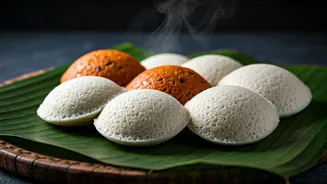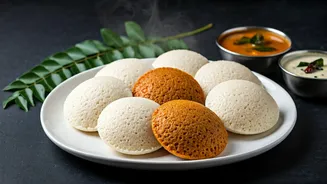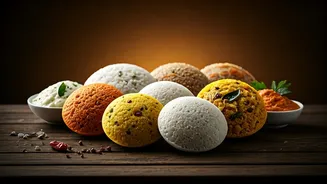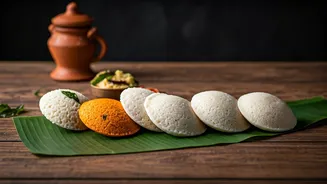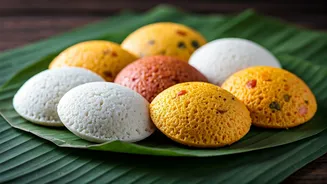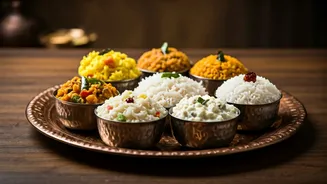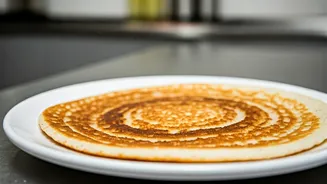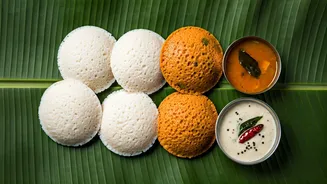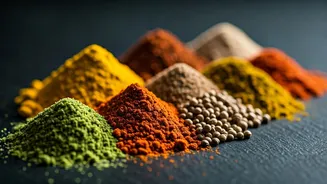The Classic: Plain Idli
Plain idli serves as the cornerstone of this culinary journey. Made with fermented rice and urad dal batter, these fluffy, steamed cakes offer a mild,
slightly tangy taste. They are the simplest form, often enjoyed with sambar (a lentil-based vegetable stew) and chutney (a condiment made from various ingredients like coconut or tomato). The simplicity of plain idli is its strength, providing a neutral canvas for the flavorful accompaniments. The fermentation process is critical, as it contributes to the signature airy texture and the subtle sourness that defines a good idli. Often served in various sizes, it's a versatile dish that forms the base of many other variations.
Thatte Idli's Charm
Thatte idli, from Karnataka, is notably larger and flatter than regular idli, resembling a small plate ('thatte' means plate). This distinctive shape is achieved by steaming the batter in large, flat molds. Thatte idli is slightly denser than plain idli, offering a satisfying bite. It's often served with a generous helping of butter or ghee, enhancing its richness and flavor. Popular accompaniments include sambar and chutney, though the idli's size allows for a heartier meal. It is a popular street food option, appreciated for its filling nature and easy portability. The texture is key, with a slight chewiness that differentiates it from the softer plain idli.
Kanchipuram Idli Delights
Kanchipuram idli, a specialty from Tamil Nadu, is a flavorful and aromatic version. The batter includes ingredients like ginger, cumin, pepper, and sometimes even cashew nuts, resulting in a more savory taste. Often, the batter is steamed in small, individual molds, creating perfectly shaped idlis. The addition of spices gives Kanchipuram idli a distinct aroma and taste, making it a favorite for those who enjoy a spicier breakfast. The inclusion of asafoetida provides a digestive benefit and an additional layer of flavor. It's commonly eaten with a side of chutney and sambar. The use of tempering in the preparation adds another dimension, elevating this idli above the ordinary.
Rava Idli: Quick & Easy
Rava idli offers a convenient alternative, made with semolina (rava or suji) instead of fermented rice and lentils. This makes it a quicker option, as it doesn't require the overnight fermentation process. While rava idli typically doesn't have the same fluffiness as regular idli, it still provides a pleasant texture, often with added vegetables and spices for flavor. Commonly, it is mixed with curd to help with the fermentation process and give it a softer texture. It’s frequently tempered with mustard seeds, curry leaves, and other spices, adding another layer of flavor. Rava idli is often served with sambar and chutney, making it a delicious and satisfying breakfast choice.
The Unique: Idli Variants
Several interesting variations exist beyond these main types. Some recipes incorporate ingredients like oats, ragi (finger millet), or other grains to increase the nutritional value and provide different textures. There are also versions that include chopped vegetables, herbs, or even grated carrots or beets for both flavor and color. These innovations allow cooks to experiment with different tastes and nutritional profiles. Often, these variations are created by home cooks, allowing for many personalized recipes. Each type of idli offers a distinct experience, from the classic simplicity to the more complex, spiced options.
Sambar: The Ultimate Pair
Sambar, a lentil-based vegetable stew, is the quintessential accompaniment to idli. Made with toor dal (split pigeon peas) as the base, sambar typically includes a medley of vegetables like drumsticks, eggplant, and pumpkin. A blend of spices, including sambar powder, provides a flavorful and aromatic broth. The stew is cooked until the vegetables are tender, creating a hearty and satisfying accompaniment. Different regional variations of sambar exist, with each area bringing its own twist on the spices and vegetables used. It's an important part of the meal, adding both flavor and nutritional value. The combination of the idli's soft texture and the sambar’s robust flavor is irresistible.
Chutneys: Flavorful Companions
Chutneys provide a diverse range of flavors to complement idli. Coconut chutney, made from grated coconut, is a popular choice, offering a creamy, slightly sweet taste. Tomato chutney, made from tomatoes, onions, and spices, provides a tangy and savory counterpoint. Mint chutney and coriander chutney are another option, providing a fresh, herby flavor. Chutneys contribute texture and extra flavor complexity to the meal. The variety of chutneys allows people to tailor their idli experience to their individual tastes, from mild and creamy to spicy and vibrant. The flavors vary from mildly sweet to extremely hot and spicy.
